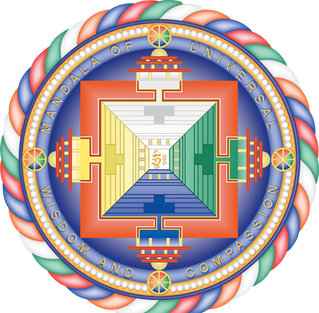
Chakras are various focal points used in a variety of ancient meditation practices, collectively denominated as Tantra, or the esoteric or inner traditions of Hinduism and Buddhism.

Yoga is a group of physical, mental, and spiritual practices or disciplines which originated in ancient India and aim to control (yoke) and still the mind, recognizing a detached witness-consciousness untouched by the mind (Chitta) and mundane suffering (Duḥkha). There is a wide variety of schools of yoga, practices, and goals in Hinduism, Buddhism, and Jainism, and traditional and modern yoga is practiced worldwide.

Bon or Bön, also known as Yungdrung Bon, is the indigenous Tibetan religion which shares many similarities and influences with Tibetan Buddhism. It initially developed in the tenth and eleventh centuries but retains elements from earlier Tibetan religious traditions. Bon is a significant minority religion in Tibet, especially in the east, as well as in the surrounding Himalayan regions.

Shaivism is one of the major Hindu traditions, which worships Shiva as the Supreme Being. One of the largest Hindu denominations, it incorporates many sub-traditions ranging from devotional dualistic theism such as Shaiva Siddhanta to yoga-orientated monistic non-theism such as Kashmiri Shaivism. It considers both the Vedas and the Agama texts as important sources of theology. According to a 2010 estimate by Johnson and Grim, Shaivism is the second-largest Hindu sect, constituting about 253 million or 26.6% of Hindus.

Buddhist meditation is the practice of meditation in Buddhism. The closest words for meditation in the classical languages of Buddhism are bhāvanā and jhāna/dhyāna.

The culture of Nepal encompasses the various cultures belonging to the 125 distinct ethnic groups present in Nepal. The culture of Nepal is expressed through music and dance; art and craft; folklore; languages and literature; philosophy and religion; festivals and celebration; foods and drinks.

The New Kadampa Tradition – International Kadampa Buddhist Union (NKT—IKBU) is a global Buddhist new religious movement founded by Kelsang Gyatso in England in 1991. In 2003 the words "International Kadampa Buddhist Union" (IKBU) were added to the original name "New Kadampa Tradition". The NKT-IKBU is an international organisation registered in England as a charitable, or non-profit, company. It currently lists more than 200 centres and around 900 branch classes/study groups in 40 countries. The BBC describe the New Kadampa Tradition as "one of the major Buddhist schools in the UK, founded by the Tibetan-born Geshe Kelsang Gyatso."
Sampradaya, in Indian origin religions, namely Hinduism, Buddhism, Jainism, and Sikhism, can be translated as 'tradition', 'spiritual lineage', 'sect', or 'religious system'. To ensure continuity and transmission of dharma, various sampradayas have the Guru-shishya parampara in which parampara or lineage of successive gurus (masters) and shishyas (disciples) serves as a spiritual channel and provides a reliable network of relationships that lends stability to a religious identity. Shramana is vedic term for seeker or shishya. Identification with and followership of sampradayas is not static, as sampradayas allows flexibility where one can leave one sampradaya and enter another or practice religious syncretism by simultaneously following more than one sampradaya. Samparda is a punjabi language term, used in Sikhism, for sampradayas.

The Foundation for the Preservation of the Mahayana Tradition (FPMT) was founded in 1975 by Gelugpa Lamas Thubten Yeshe and Thubten Zopa Rinpoche, who began teaching Tibetan Buddhism to Western students in Nepal. The FPMT has grown to encompass over 138 dharma centers, projects, and services in 34 countries. Lama Yeshe led the organization until his death in 1984, followed by Lama Zopa until his death in 2023. The FPMT is now without a spiritual director; meetings on the organization's structure and future are planned.
Buddhism, also known as Buddha Dharma, and Dharmavinaya, is an Indian religion or philosophical tradition based on teachings attributed to the Buddha. It originated in the eastern Gangetic plain as a śramaṇa–movement in the 5th century BCE, and gradually spread throughout much of Asia via the Silk Road. It is the world's fourth-largest religion, with over 520 million followers (Buddhists) who comprise seven percent of the global population.

Dhyāna in Hinduism means contemplation and meditation. Dhyana is taken up in Yoga practices, and is a means to samadhi and self-knowledge.

Buddhism and Hinduism have common origins in the culture of Ancient India. Buddhism arose in the Gangetic plains of Eastern India in the 5th century BCE during the "second urbanisation". Hinduism developed as a fusion or synthesis of practices and ideas from the ancient Vedic religion and elements and deities from other local Indian traditions. This Hindu synthesis emerged after the Vedic period, between 500-200 BCE and c. 300 CE, in or after the period of the Second Urbanisation, and during the early classical period of Hinduism, when the Epics and the first Puranas were composed.
Lamdré is a meditative system in Tibetan Buddhism rooted in the view that the result of its practice is contained within the path. The name "lamdré" means the “path" with its fruit Wylie: ‘bras). In Tibet, the lamdré teachings are considered the summum bonum of the Sakya school.

Francis Xavier Clooney is an American Jesuit priest and scholar in the teachings of Hinduism. He is currently a professor at Harvard Divinity School in Cambridge, Massachusetts.

In the oldest texts of Buddhism, dhyāna or jhāna is a component of the training of the mind (bhavana), commonly translated as meditation, to withdraw the mind from the automatic responses to sense-impressions, "burn up" the defilements, and leading to a "state of perfect equanimity and awareness (upekkhā-sati-parisuddhi)." Dhyāna may have been the core practice of pre-sectarian Buddhism, in combination with several related practices which together lead to perfected mindfulness and detachment.
Samatha, "calm," "serenity," "tranquility of awareness," and vipassanā, literally "special, super, seeing ", are two qualities of the mind developed in tandem in Buddhist practice.
Secular Buddhism—sometimes also referred to as agnostic Buddhism, Buddhist agnosticism, ignostic Buddhism, atheistic Buddhism, pragmatic Buddhism, Buddhist atheism, or Buddhist secularism—is a broad term for a form of Buddhism based on humanist, skeptical, and agnostic values, valuing pragmatism and (often) naturalism, eschewing beliefs in the supernatural or paranormal. It can be described as the embrace of Buddhist rituals and philosophy for their secular benefits by people who are atheist or agnostic.

David Francis Germano is an American Tibetologist and Professor of Tibetan and Buddhist Studies at the University of Virginia (UVa), the largest Tibetan Studies program in the Americas, where he has taught and researched since 1992. With dual appointments in the School of Nursing and the Department of Religious Studies, Germano currently oversees the work of over twenty graduate students. He is on the board of the International Association of Tibetan Studies and is Editor-in-Chief of The Journal of the International Association of Tibetan Studies (JIATS), a leading journal of Tibetology. In 2000, he founded the Tibetan and Himalayan Library, a digital initiative for collaborative building of knowledge on the region, which he continues to lead as Director. Since 2008 he has also been the co-director of the UVa Tibet Center. More recently, Germano acted as the founding director of SHANTI at the UVa. Since 2011, Germano has also played a leading role in organizing the University of Virginia's Contemplative Sciences Center, which he currently directs.
John Powers is American born Professor of Asian Studies and Buddhism. Much of his teaching career was at the Australian National University in Canberra.
Anne Cushman is an American teacher of yoga as exercise and meditation, a writer on Mindful Yoga, and a novelist. Her novel Enlightenment for Idiots was named by Booklist as one of the top ten novels of 2008. Cushman has also been an editor for Yoga Journal and Tricycle: The Buddhist Review. She directs mentoring programs and multi-year meditation training for yoga teachers at the Spirit Rock Meditation Center, emphasizing the fusion of yoga and Buddhist meditation and highlighting their shared history and philosophy.













